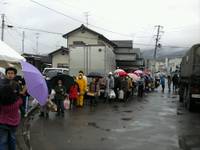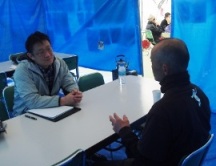 JEN volunteers prepared 3,000 bowls of freshly cooked ramen to serve to people in Ishinomaki (Miyagi Prefecture) over a three-day period. On the first day, they set up a stand by the Watanoha Station, where trains have stopped coming since the earthquake. Despite the rain and the chilly weather, a long line formed and the team served 1,200 meals on that day alone.
JEN volunteers prepared 3,000 bowls of freshly cooked ramen to serve to people in Ishinomaki (Miyagi Prefecture) over a three-day period. On the first day, they set up a stand by the Watanoha Station, where trains have stopped coming since the earthquake. Despite the rain and the chilly weather, a long line formed and the team served 1,200 meals on that day alone.
 The Japan Association for Refugees (JAR) is one of the member organizations of Japan Platform (JPF) that is receiving funding for its relief efforts. On April 16, JAR began offering legal consultations for people in Rikuzentakata (Iwate Prefecture). The evacuees have many concerns at the moment: What happens to the mortgage on their house that was swept away? Are they still responsible for car payments and other payments? They’ve lost a spouse or parent, but what happens in terms of the inheritance and life insurance? What if their loved one is still missing? As a business owner, what are they liable for and what help can they receive? These worries place enormous stress on the evacuees. The local government and lawyers’ association are doing some work in this area, but JAR is trying to visit the more difficult to access evacuation centers and nursing homes that have not yet received such help.
The Japan Association for Refugees (JAR) is one of the member organizations of Japan Platform (JPF) that is receiving funding for its relief efforts. On April 16, JAR began offering legal consultations for people in Rikuzentakata (Iwate Prefecture). The evacuees have many concerns at the moment: What happens to the mortgage on their house that was swept away? Are they still responsible for car payments and other payments? They’ve lost a spouse or parent, but what happens in terms of the inheritance and life insurance? What if their loved one is still missing? As a business owner, what are they liable for and what help can they receive? These worries place enormous stress on the evacuees. The local government and lawyers’ association are doing some work in this area, but JAR is trying to visit the more difficult to access evacuation centers and nursing homes that have not yet received such help.
The Association for Aid and Relief (AAR) posted the latest update on their ongoing relief efforts. As of April 25, they had distributed relief items in roughly 360 locations, reaching about 45,000 people. The donations they have received from within Japan and from overseas have allowed them to distribute: 3,600 gallons of diesel fuel, 1,200 gallons of kerosene, 550 gallons of gasoline, 13 tons of water, 2 tons of rice, 2 tons each of tangerines and bananas, 480 packs of milk, many other food items, 1,000 blankets, 25,000 items of clothing, 50,000 towels, 60,000 face masks (to prevent the spread of disease), 5,000 hand warmers, 3,400 sleeping bags, 60 boxes of cold medicine, 10,000 tooth brushes, 60,000 diapers, 80 boxes of batteries, children’s items (pacifiers, baby food, etc.), 30 power washers, 30 chain saws, 100 pairs of rubber boots, 20 boxes of books, 200 sets of crayons, 120 cell phone chargers, 6 computers, 70 bicycles, 8 washing machines, 8 clothes dryers, and many other items.
